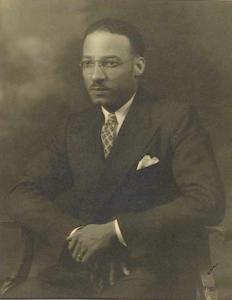PostClassical Ensemble spotlights the neglected music of William Dawson

Music of William Dawson was celebrated in a concert by the PostClassical Ensemble Friday night.
PostClassical Ensemble has devoted three concerts this season to a project rediscovering classical music by African-American composers. For the last of these, Friday night at Duke Ellington School of the Arts, Angel Gil-Ordóñez conducted a program devoted to the music of William Dawson. The event also featured student performers, capping a week of collaboration with PCE’s professional musicians.
The music started a half-hour late, after a pre-concert talk with tenor George Shirley, also featured in the program, ran long. Shirley was the first African-American to sing a tenor role at the Metropolitan Opera, only one of his many ground-breaking achievements. Shirley’s connections to the Washington area include his service as the first black member of the U.S. Army Chorus and tenure on the faculty of the University of Maryland.
Shirley joined the Duke Ellington School of the Arts Concert Chorale for the opener, William Dawson’s arrangement of the spiritual “There is a Balm in Gilead.” Dawson, who was born in Alabama in 1899, studied music at the Tuskegee Institute, the college first led by Booker T. Washington, and later returned there as head of the school of music. He wrote his many arrangements of spirituals for the Tuskegee Institute Choir, which he conducted.
The students sang the piece with poise and fervor, well disciplined by their conductor, Monique Spells. All sections contributed evenly and with effective balance and intonation, moving at a stately tempo. Shirley himself, now 87, took the solo part with a wavering but still intense tone, quite moving to hear. Another Duke Ellington student, Zephyr Henderson, then read her poem “On My Way,” offering it as a tribute to the doors that Shirley had helped open for black artists.
Gil-Ordóñez then led the PostClassical Ensemble musicians in the world concert premiere of Dawson’s Negro Work Song, an unpublished orchestral work. Gil-Ordóñez thanked Dawson’s niece, who was in the audience, for allowing PCE to reconstruct the piece from the composer’s original manuscript.
A somber, hypnotizing tune began in the trumpet, passing to the solo cello and then rising steadily into a full orchestral treatment. Befitting the nature of the tune, the piece remained bleak, plodding ahead at a steady pace. Near the work’s conclusion, the opening trumpet motif returned, this time accompanied by dramatic string tremolos.
The group then presented the second performance of Dawson’s Negro Folk Symphony heard this season. Billed as the D.C. premiere, the slightly smaller PCE forces gave a potent but less lustrous rendition than the one led by James Conlon with the Baltimore Symphony Orchestra in October. A polished French horn solo opened the first movement (“The Bond of Africa”), on the theme that Dawson identified as the link “taken out of a human chain when the first African was taken from the shores of his native land and sent to slavery.”
Dawson used African-American spirituals prominently in this piece as well. Gil-Ordóñez carefully regulated sectional balances to allow delicate woodwind parts to be heard in the second theme, reworked from the tune of “Oh, My Little Soul Gwine-a Shine.” It is likely, scholars have noted, that the opening “link” theme is derived from the spiritual “Hallelujah, Lord, I Been Down Into the Sea,” which is quoted more directly in the work’s final movement. Full brass resonated on this theme toward the end of the first movement.
Plaintive English horn set the tone of the second movement (“Hope in the Night”), marked by a pleading insistence, sighing softly. The playful oboe launched the contrasting middle section, which the composer likened to the sound of children playing. The odd conclusion of this movement, a drawn-out tonic chord in swelling crescendo and decrescendo, seethed with tension, reinforced by the beating of a tom-tom.
PCE played the composer’s 1952 revision of the symphony, the version eventually recorded by Leopold Stokowski, who had premiered the work at Carnegie Hall in 1934. Dawson made the revision after he took a trip to seven countries in West Africa, writing that he wanted to infuse the piece “with a rhythmic foundation strongly inspired by African influences.” In the first movement, the composer added Juba rhythms from dances brought by slaves from the Kingdom of Kongo to plantations in South Carolina.
Brass and woodwinds all added capable solos to the vivacious third movement, which also quotes the spiritual “O, Le’ Me Shine, Shine Like a Morning Star!” Pulsating with syncopated rhythms, the finale built to an exuberant climax.
In his new book Dvořák’s Prophecy and the Vexed Fate of Black Classical Music, PCE executive producer Joseph Horowitz includes Louis Gottschalk as an American composer “inspired by the Black motherlode” from his childhood in the south. Gottschalk always identified as white, although his mother came from a Creole family once living in Haiti. His European father was, among other things, a slave trader in New Orleans.
Musicians from PCE joined with students from the Duke Ellington School of the Arts Orchestra for a rough-and-unready performance of Gottschalk’s two-movement symphony Night in the Tropics, as reconstructed by Gaylen Hatton. After the first movement, conducted by Gil-Ordóñez, a group of percussionists took center stage for an impromptu introduction to the second movement (“Festa Criolla”), reportedly the first orchestral samba, conducted by Isaac Daniel with verve.
PostClassical Ensemble performs music by Gustav Mahler, including a chamber ensemble arrangement of the Fourth Symphony, 7:30 p.m. April 30. postclassical.com


